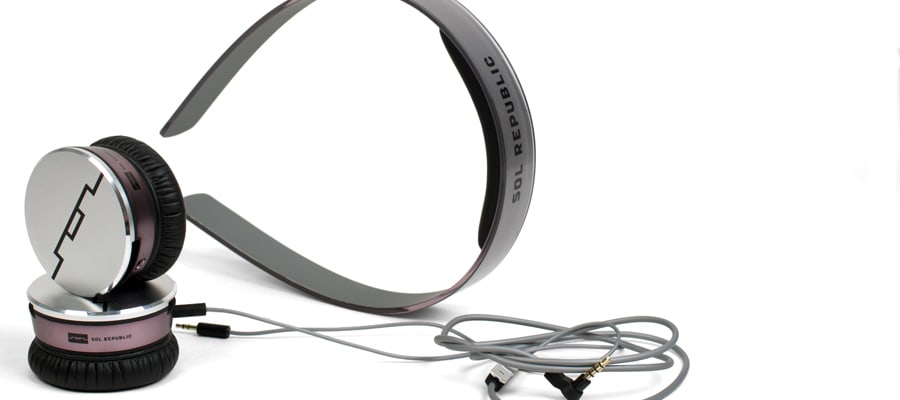At a Glance
At least no one will start a war over Sol Republic's Tracks HD on ears... unless it's in attempt to return them. While customizable, durable, and great looking, the Tracks HD don't back things up with quality sound or comfort.
Audio Quality
Definitely not 130-dollar sound
Your piggy bank does not deserve to die for the Tracks HD. Sol Republic promises to deliver "deeper bass"—and they do. In fact, the bass sometimes seems like all you can hear; prominent portions of the midrange, as well as many high notes, are very underemphasized. Even bass lovers may not appreciate the fact that vocals get masked; the same unpleasant effect impacts the midrange and highest notes on everything from strings, to woodwinds, to percussion, brass, and more. The rata-tat tat of a snare drum in one of my favorite songs was sadly diminished.
Problems continue from there. The lowest sub bass notes are nearly twice as loud in the right ear as in the left. Enjoy that Deadmau5— in one ear! High frequencies are also much louder in the right ear, but at least the rest of the range is nicely balanced.
Worst of all, you can't even listen to these ho-hum headphones in peace, because the Tracks HD are lousy isolators, too. Normally, on ears do a fine job blocking out midrange and high range noise pollutants, but the Tracks only combat the high range irritants. At this very moment, construction workers on the second floor are banging away on demolition duty, and the low poundings break right past my music. The game of Magic transpiring to my right? Well, at least I can't hear them.
I'm not finished! There's more! You know all that extra bass Sol Republic promised you? It comes with audible distortion.
Design & Features
Plastic as far as the eye can see
If there's one thing we do like about the Tracks HD, it's the modular build. You can swap the band, remove the ear cups, and detach the Y-shaped cable. Headbands come in silver, red, purple, and many more. If you want a blue band, silver ear cups, and a purple cord, you can have it. Quite literally, you can replace anything on the Tracks HD, so if you break something at least you don't need to replace the entire rig.
The headband doesn't fold in half, but it does detach from the ear cups. The band is very flexible—nearly indestructible in fact, but as far as packing it up, you're stuck with a headband shape. A memory foam cushion lends a comfy feel to the upper curve of the headband, and the same material pads each ear cup. After that, it's plastic, plastic, plastic.
Designers included a plastic remote control on the four-foot cable. Users can answer calls, change songs, and tinker with volume on Apple devices, but on my coworker's Android, I noticed that the volume controls didn't work.
{{photo_gallery "design",}}
In Use
Were these made for a human head?
While the Tracks HD do come with a carry case, the fact that the band doesn't fold or collapse makes them rather inconvenient for on the go. The band does appear to be quite durable, though; we twisted, bent, and contorted the band as rigorously as we pleased—it flipped back to its original shape without a scratch, crack, or dent.
But the fit is awful. The Tracks HD feel... wrong. Most people's ears aren't perfectly flat—our ears tend to sit at a bit of an angle. These headphones sit flush on either side of the head, with no allowance for the natural angle of the ears—which probably accounts for both the poor isolation and the discomfort.
Additionally, when you don the Tracks HD and attempt to adjust the ear cups to suit your head, you will find the task at hand much more difficult than usual. Adjusting an ear cup requires two hands—one to hold the band in place on top, and the other to cajole the stubborn, slow-moving cup into place. This turned out to be a constant frustration—a fit like this for $130 is inexcusable. It was a relief to be finished with the Tracks. Replacing them with over ears felt like swapping a suit for some pajamas—sweet relief!
Conclusion
Not on track
This is no way to spend upwards of 100 dollars. The Sol Republic Tracks HD allow for bass to overwhelm. With an imbalance like this, music loses much of its mid and high range complexity. And the fit is terrible; since the ear cups don't pivot at all, it's nearly impossible to get a comfortable fit—these don't feel designed for a human head.
From comfort, to frequency response, to price, the Tracks HD can't keep up with competition. You can do better. What if they go on sale? That's probably just a sign that everyone's doing better.
The Numbers
Testing Sol Republic's Track HDs made for a dark day indeed. Wearing them was no fun at all, due to the uncomfortable design, and testing produced poor results time and time again. The Science Page is here to show you why these headphones are rated so poorly.
Frequency Response
Mids and highs that can't keep up with the big bass
Consumer tastes have driven audio engineers in a particular direction in recent years. Instead of a flat response to suit the studio need, many consumer headphones follow an equal loudness curve. Since humans perceive different frequencies in different ways, the loudness of each frequency along an equal loudness curve varies—so that each one is perceived as equally loud to the human ear.
{{photo_gallery "freq",}}
The Tracks HD appear to roughly follow that contour. I say roughly because while the overall shape looks similar to an equal loudness curve, there are some key diversions: First, the lowest portion of the sub-bass range is actually underemphasized. And by sub-bass, I'm talking the lowest of the low—20 to 30Hz only impacts a few instruments, namely the lowest doldrums of an 88-key piano, the pipe organ, the bassoon, and a couple of others.
The rest of the bass notes is about where it ought to be, yet it overwhelms the sound in these headphones because it masks notes in the 400 to 500Hz range—quieting a chunk of midrange notes on every instrument in the book, including vocals. This midrange isn't totally lost, since from 600-900kHz the response is quite healthy. From 2kHz - 7kHz, the loudness again plummets so that high frequencies such as upper notes on strings and woodwinds are all but lost amid the boisterous bass.
Distortion
Audible distortion batters at bass
Some people will argue that they want a super bassy set of headphones. Fine. But would you like audible distortion with that? The chart may look innocent, but the fact is, the sound suffers as much as 60% total harmonic distortion.
{{photo_gallery "dist",}}
Other Tests
Looking further...
{{photo_gallery "other",}}
Meet the tester
Virginia is a former Managing Editor at Reviewed.com. She has a background in English and journalism. Away from the office, Virginia passes time with dusty books & house cats.
Checking our work.
Our team is here to help you buy the best stuff and love what you own. Our writers, editors, and experts obsess over the products we cover to make sure you're confident and satisfied. Have a different opinion about something we recommend? Email us and we'll compare notes.
Shoot us an email

